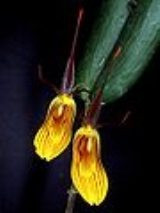
Restrepia falkenbergii
Encyclopedia
Restrepia falkenbergii, commonly called the Falkenberg's Restrepia, is an epiphytic
orchid, found at altitudes between 1,000-2,000 m in Colombia.
This large orchid lacks pseudobulb
s. The erect, thick, leathery leaf is elleptic-ovate in shape. The aerial root
s seem like fine hairs.
The flowers develop one at a time at the base of the leaf. They are borne on a slender peduncle, originating from the base of the back of the leaf. The long dorsal sepal
is erect and ends in a somewhat thicker club-shaped tip. They have fused lateral sepals (synsepals) with a length of about 2.5 cm. These are quite colorful : overall yellow, with orange, tan and red at the back, overlaid with contrasting reddish-purple stripes. The long, lateral petal
s equally end in a thickened club-shaped tip.
The long and smooth lip
is pandurate and widest its apex. It shows the same variations in color and markings.
Epiphyte
An epiphyte is a plant that grows upon another plant non-parasitically or sometimes upon some other object , derives its moisture and nutrients from the air and rain and sometimes from debris accumulating around it, and is found in the temperate zone and in the...
orchid, found at altitudes between 1,000-2,000 m in Colombia.
This large orchid lacks pseudobulb
Pseudobulb
The pseudobulb is a storage organ derived from the part of a stem between two leaf nodes.It applies to the orchid family , specifically certain groups of epiphytic orchids, and may be single or composed of several internodes with evergreen or deciduous leaves along its length.In some species, it is...
s. The erect, thick, leathery leaf is elleptic-ovate in shape. The aerial root
Root
In vascular plants, the root is the organ of a plant that typically lies below the surface of the soil. This is not always the case, however, since a root can also be aerial or aerating . Furthermore, a stem normally occurring below ground is not exceptional either...
s seem like fine hairs.
The flowers develop one at a time at the base of the leaf. They are borne on a slender peduncle, originating from the base of the back of the leaf. The long dorsal sepal
Sepal
A sepal is a part of the flower of angiosperms . Collectively the sepals form the calyx, which is the outermost whorl of parts that form a flower. Usually green, sepals have the typical function of protecting the petals when the flower is in bud...
is erect and ends in a somewhat thicker club-shaped tip. They have fused lateral sepals (synsepals) with a length of about 2.5 cm. These are quite colorful : overall yellow, with orange, tan and red at the back, overlaid with contrasting reddish-purple stripes. The long, lateral petal
Petal
Petals are modified leaves that surround the reproductive parts of flowers. They often are brightly colored or unusually shaped to attract pollinators. Together, all of the petals of a flower are called a corolla. Petals are usually accompanied by another set of special leaves called sepals lying...
s equally end in a thickened club-shaped tip.
The long and smooth lip
Labellum
Labellum is the Latin diminutive of labium, meaning lip. These are anatomical terms used descriptively in biology, for example in Entomology and botany.-Botany:...
is pandurate and widest its apex. It shows the same variations in color and markings.

